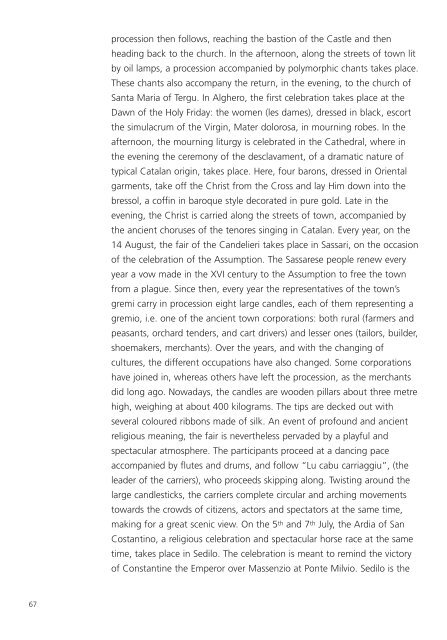You also want an ePaper? Increase the reach of your titles
YUMPU automatically turns print PDFs into web optimized ePapers that Google loves.
procession then follows, reaching the bastion of the Castle and then<br />
heading back to the church. In the afternoon, along the streets of town lit<br />
by oil lamps, a procession accompanied by polymorphic chants takes place.<br />
These chants also accompany the return, in the evening, to the church of<br />
Santa Maria of Tergu. In Alghero, the first celebration takes place at the<br />
Dawn of the Holy Friday: the women (les dames), dressed in black, escort<br />
the simulacrum of the Virgin, Mater dolorosa, in mourning robes. In the<br />
afternoon, the mourning liturgy is celebrated in the Cathedral, where in<br />
the evening the ceremony of the desclavament, of a dramatic nature of<br />
typical Catalan origin, takes place. Here, four barons, dressed in Oriental<br />
garments, take off the Christ from the Cross and lay Him down into the<br />
bressol, a coffin in baroque style decorated in pure gold. Late in the<br />
evening, the Christ is carried along the streets of town, accompanied by<br />
the ancient choruses of the tenores singing in Catalan. Every year, on the<br />
14 August, the fair of the Candelieri takes place in Sassari, on the occasion<br />
of the celebration of the Assumption. The Sassarese people renew every<br />
year a vow made in the XVI century to the Assumption to free the town<br />
from a plague. Since then, every year the representatives of the town’s<br />
gremi carry in procession eight large candles, each of them representing a<br />
gremio, i.e. one of the ancient town corporations: both rural (farmers and<br />
peasants, orchard tenders, and cart drivers) and lesser ones (tailors, builder,<br />
shoemakers, merchants). Over the years, and with the changing of<br />
cultures, the different occupations have also changed. Some corporations<br />
have joined in, whereas others have left the procession, as the merchants<br />
did long ago. Nowadays, the candles are wooden pillars about three metre<br />
high, weighing at about 400 kilograms. The tips are decked out with<br />
several coloured ribbons made of silk. An event of profound and ancient<br />
religious meaning, the fair is nevertheless pervaded by a playful and<br />
spectacular atmosphere. The participants proceed at a dancing pace<br />
accompanied by flutes and drums, and follow “Lu cabu carriaggiu”, (the<br />
leader of the carriers), who proceeds skipping along. Twisting around the<br />
large candlesticks, the carriers complete circular and arching movements<br />
towards the crowds of citizens, actors and spectators at the same time,<br />
making for a great scenic view. On the 5 th and 7 th July, the Ardia of San<br />
Costantino, a religious celebration and spectacular horse race at the same<br />
time, takes place in Sedilo. The celebration is meant to remind the victory<br />
of Constantine the Emperor over Massenzio at Ponte Milvio. Sedilo is the<br />
67
















